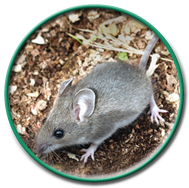GROUND NESTING BEES IN CONNECTICUT
I got a call this week from a customer who was very concerned about the ground nesting bees on his property, after speaking with him I realized how uninformed most people are about these useful pollinators which prompted me to write.
Similar to honey bees the various species of ground nesting bees are extraordinary pollinators for many fruit baring trees and shrubs including tomatoes, melons, and apple blossoms. Due to the dying off of honey bees, having some of these ground nesting bees on your property could be a significant blessing. Most commonly the bees encountered here in Connecticut that will nest in soil are the cellophane and sweat bees. The females will dig quarter to half inch-wide tunnels in areas where the grass is sparse and the soil is loose and dry. They then construct chambers and deposit nectar and pollen inside to feed the emerging offspring. The cellophane bees are solitary so each female constructs her own nest, sometimes the nests of several solitary females will be close together giving you the feeling of “a huge nest with hundreds of bees” on your property.
In most situations it is not necessary to eliminate these ground bees as they are helpful to the fruit ecology. These ground bees rarely sting unless provoked, preferring to retreat. They will sting if cornered and accidentally if stepped on. Their main activity will last between three and four weeks. The best way to rid them is by fixing the conditions of your soil. You can try and till your soil, add organic matter, and start spreading grass seed in patchy area and keep watered.
Yellow-jackets will also nest in the ground, using old rodent holes and hollow logs as nesting sites. Unlike fuzzy bees the Yellow-jacket is not much of a pollinator at all. Barely visiting flowers and if they do its most likely to kill another insect. If you have these guys nesting in your soil its a different story. Yellow-jackets can be a nuisance and if you have young children running around barefoot in your yard, a ground nest on your property can be cause for concern. The solution to this problem may require the use of insecticides to eliminate.
If you have ground bees on your property have a professional from Guardian come out and identify the species, put a plan into action, and together we can help to solve your problem.
Officials are saying Connecticut is experiencing an “extraordinary” season for ticks this year. Close to 40 percent of ticks tested so far were positive for the bacteria causing Lyme disease. There are many other tick-borne illnesses other than Lyme Disease such as the Powassan Virus, Anaplasmosis, Babesiosis, and Rocky Mountain Spotted Fever. Because of these illnesses, the “extraordinary” tick season is a growing concern.
CAUSE
The large tick numbers are due to a couple of things.
The mild winters that we have had the past 2 years has resulted in higher over-wintering survival of the ticks, which are in the leaf litter. Also there has been a significant increase in the number of small rodents specifically the white-footed mouse, which is the primary host for the larval stage of ticks.
PREVENTION
Most people get ticks while working or playing in and around the home. The areas of highest risk are shaded areas at the border of lawns, and your tree line.
You can also try to prevent exposure of Lyme disease and other tick-borne diseases by reducing your exposure to tick bites. Tick-borne diseases generally occur during the summer months when ticks are most active.
Try and use the following personal protection measures:
- Avoid tall grass and over-grown areas
- If hiking stay in the middle of the trail
- Apply a tick repellent
- Tuck your pant legs into your socks
- Wear long-sleeved shirts and closed shoes or boots
- Wear light-colored clothes to help see the ticks easier
- Examine yourself, children, and pets for ticks when coming from outside
- Check underarms, scalp, groin, ears, and any other warm dark areas for attached ticks
- Have your property treated regularly by a licensed professional for tick control
ACTION
If you can remove an infected tick within 24 to 48 hours you can reduce the likelihood of Lyme infection.
Here is a tip from the Center For Disease Control:
“If you find a tick attached to your skin, there’s no need to panic. There are several tick removal devices on the market, but a plain set of fine-tipped tweezers will remove a tick quite effectively.
How to remove a tick:
Use fine-tipped tweezers to grasp the tick as close to the skin’s surface as possible.
Pull upward with steady, even pressure. Don’t twist or jerk the tick; this can cause the mouth-parts to break off and remain in the skin. If this happens, remove the mouth-parts with tweezers. If you are unable to remove the mouth easily with clean tweezers, leave it alone and let the skin heal.
After removing the tick, thoroughly clean the bite area and your hands with rubbing alcohol, an iodine scrub, or soap and water.
Dispose of a live tick by submersing it in alcohol, placing it in a sealed bag/container, wrapping it tightly in tape, or flushing it down the toilet. Never crush a tick with your fingers.”
https://www.cdc.gov/ticks/removing_a_tick.html
This is the time you want to get your property treated for ticks, call Guardian Pest Control today and get a free quote for treatment.
Mosquitoes can carry many different diseases including Dengue fever, West Nile virus, Eastern Equine Encephalitis, Malaria and now the Zika virus, which makes it even more important to eliminate breeding areas around your home and property.
Mosquitoes lay their eggs in standing water; the better you are at eliminating these areas the smaller mosquito population you’ll have on your property. Common areas to look for mosquitoes are bird baths, empty pots, clogged gutters, tires, and buckets.
If you plan on spending time outside this spring and summer, consider using spray repellents with DEET and wear long sleeve shirts and pants. Mosquitoes are attracted to carbon dioxide (when we exhale), bright colors, movement, and certain perfumes. The female mosquito is the only one that feeds on humans but both the female and male feed on nectar.
Guardian Pest Control has a safe and effective treatment that eliminates adult mosquitoes on contact. Our technicians apply this treatment around your property using a mist blower. Each treatment lasts about 30 days. Each treatment eliminates approximately 90% of the adult mosquito population in your yard, allowing you to enjoy your back yard again.
Contact Guardian Pest Control today for
a free quote and more information.
Carpenter bees may look like bumble bees but there are very different. A carpenter bee’s abdomen (back section) is shiny with very little hair unlike the bumble bees whose abdomen is covered with hair.
The male carpenter bees will hover around the gutter area of your home protecting its territory by chasing away any insect or person who might intrude. Although the male bee is very aggressive while protecting its territory, it does not have a stinger. The female bee drills a perfect half inch hole in the fascia of your home with six to eight galleries to lay her eggs.
A telltale sign to look for is a stain on the siding just below where the bee drills the hole. Carpenter bees prefer to borrow into old or unpainted wood and tend to stay away from freshly stained or painted wood.
It is difficult for a homeowner to eliminate carpenter bees because it is hard to get an insecticide into the hole. At Guardian Pest Control we have a special took that we use to inject an insecticide dust into the galleries and eliminate the adult and immature carpenter bees in your home. So if you see big black and yellow bees chasing you around your yard, give Guardian Pest Control a call today.

It’s cold outside and here come the mice!
Mice are active throughout the year, especially in the winter months. Mice don’t hibernate in the winter; instead they search for food and warmth near their nests. Mice will feed up to 20 times a day on almost anything but prefer nuts and seeds.
If you see a mouse or suspect mice activity in your home, you’ll likely set traps up around entry areas. One common mistake we see homeowners make is the use of poison baits. A mouse may eat poisoned bait but then slink off and die somewhere where you cannot reach it, like the inside of a wall, which leaves a terrible smell throughout your home.
If you’ve tried to get rid of the mice in your home but haven’t had success, call Guardian Pest Control. At Guardian our mice pest control service consists of three steps. We remove the mice in the home, we plug holes where mice may be entering the home, and we apply an all natural mouse repellent around the exterior of the home to keep mice out.



